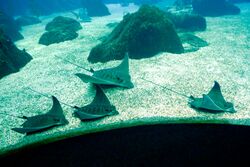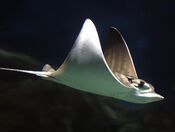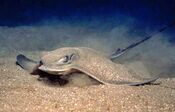Biology:Eagle ray
| Eagle ray | |
|---|---|

| |
| Bull ray (Aetomylaeus bovinus) | |
| Scientific classification | |
| Domain: | Eukaryota |
| Kingdom: | Animalia |
| Phylum: | Chordata |
| Class: | Chondrichthyes |
| Subclass: | Elasmobranchii |
| Superorder: | Batoidea |
| Order: | Myliobatiformes |
| Suborder: | Myliobatoidei |
| Superfamily: | Dasyatoidea |
| Family: | Myliobatidae Bonaparte, 1838 |
| Genera | |
The eagle rays are a group of cartilaginous fishes in the family Myliobatidae, consisting mostly of large species living in the open ocean rather than on the sea bottom.
Eagle rays feed on mollusks and crustaceans, crushing their shells with their flattened teeth. They are excellent swimmers and are able to breach the water up to several metres above the surface. Compared with other rays, they have long tails, and well-defined, rhomboidal bodies. They are ovoviviparous, giving birth to up to six young at a time. They range from 0.48 to 5.1 m (1.6 to 16.7 ft) in length and 7 m (23 ft) in wingspan.[1]
Classification
Nelson's book Fishes of the World treats cownose rays, mantas, and devil rays as subfamilies in the Myliobatidae. However, most authors (including William Toby White) have preferred to leave the Rhinopteridae and Mobulidae outside of the Myliobatidae.[2] White (2014) retained three genera (Aetobatus, Aetomylaeus, and Myliobatis) in the Myliobatidae, while a fourth (Pteromylaeus) was synoymized with Aetomylaeus.[2] A 2016 paper placed Aetobatus in its own family, the Aetobatidae.[3]
| Image | Genus | Species | Description |
|---|---|---|---|
 |
Aetomylaeus Garman, 1908 |
|
This obscure genus is distributed in the Eastern Atlantic Ocean, Indian Ocean, and Pacific Ocean. These rays were named because they lack a sting on the tail.[2] |
 |
Myliobatis Cuvier, 1816 |
|
The common eagle ray, M. aquila, is distributed throughout the Eastern Atlantic, including the Mediterranean Sea and the North Sea. Another important species is the bat eagle ray, M. californica, in the Pacific Ocean. These rays can grow extremely large, up to 1.8 m (6 ft) including the tail. The tail looks like a whip and may be as long as the body, and is armed with a sting. Eagle rays live close to the coast in depths of 1 to 30 m (3 to 98 ft) and in exceptional cases, they are found as deep as 300 m (980 ft). The eagle ray is most commonly seen cruising along sandy beaches in very shallow waters, its two wings sometimes breaking the surface and giving the impression of two sharks traveling together. |
See also
- Stingray injury
- List of prehistoric cartilaginous fish genera
References
- ↑ 1.0 1.1 Froese, R.; D., Pauly. "FAMILY Details for Myliobatidae - Eagle and manta rays". World Wide Web electronic publication. http://www.fishbase.org/summary/FamilySummary.php?ID=22.
- ↑ 2.0 2.1 2.2 2.3 2.4 White, W. T. (2014). "A revised generic arrangement for the eagle ray family Myliobatidae, with definitions for the valid genera". Zootaxa 3860 (2): 149–166. doi:10.11646/zootaxa.3860.2.3. PMID 25283197.
- ↑ White, W. T.; Naylor, G. J. P. (2016). "Resurrection of the family Aetobatidae (Myliobatiformes) for the pelagic eagle rays, genus Aetobatus". Zootaxa 4139 (3): 435–438. doi:10.11646/zootaxa.4139.3.10. PMID 27470816.
- ↑ 4.0 4.1 4.2 White, W.T.; Kawauchi, J.; Corrigan, S.; Rochel, E.; Naylor, G.J.P. (2015). "Redescription of the eagle rays Myliobatis hamlyni Ogilby, 1911 and M. tobijei Bleeker, 1854 (Myliobatiformes: Myliobatidae) from the East Indo-West Pacific". Zootaxa 3948 (3): 521–548. doi:10.11646/zootaxa.3948.3.7. PMID 25947786.
Wikidata ☰ Q6629661 entry
 |

